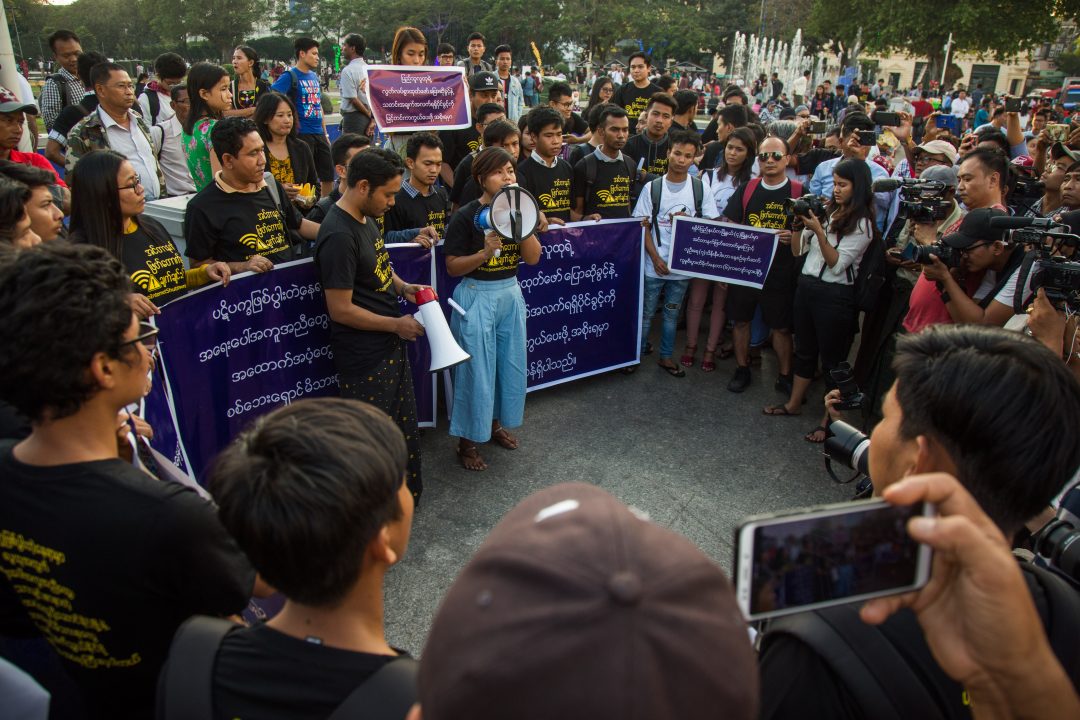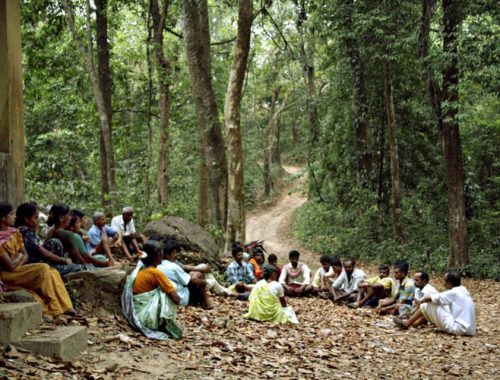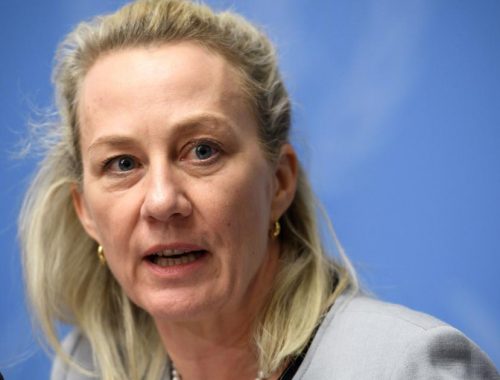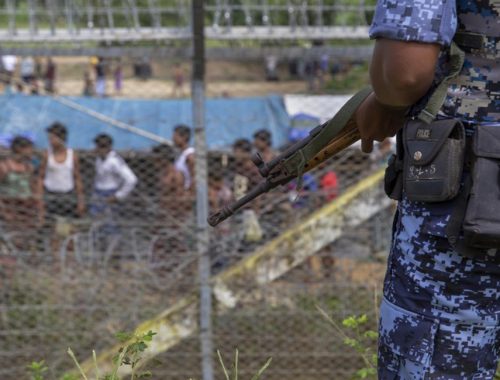On June 9, Prannoy Roy stood at a lectern in front of a crowd of journalists at the Press Club of India in New Delhi. The journalists had gathered to protest against the recent raids on NDTV, India’s oldest TV news channel, by the Central Bureau of Investigation.
“They’re trying to tell us we can suppress you even if you have done nothing wrong … and to be clear, that is a signal for the entire free press of India,” he told his audience. Roy, who co-founded the channel with his wife Radhika, had seen their own home raided in an investigation into bank fraud charges which he dismissed as “ridiculous, concocted”.

The NDTV raids follow a busy year and a half for Indian free speech activists. In February, finance minister Arun Jaitley drew a sharp rebuke from liberal onlookers and critics of the ruling Bharatiya Janata Party (BJP) when he argued that freedom of expression should be subordinate to upholding the sovereignty of the country.
WATCH: India’s NDTV raid a ‘defining moment’ for press freedom – The Listening Post (9:27)
Jaitley, speaking at the London School of Economics (LSE), had been asked to comment on the term “antinational”, recently hurled at left-wing students during bloody clashes at Ramjas College in New Delhi. There, a two-day seminar had been derailed when members of the ABVP, a right-wing student group linked to the BJP, grew violent to mark their displeasure at some of the speakers in the programme.
The ABVP objected particularly to the scheduled presence of left-wing student leader and PhD candidate Umar Khalid. A year earlier, Khalid had been branded “antinational” by political opponents and right-wing media personalities and had spent close to a month in jail after being arrested on colonial-era sedition charges for participating in an event commemorating the 2013 execution of Kashmiri separatist Afzal Guru.
Attacks on free speech
Khalid is clear: the government is “criminalising very normal political activity as seditious”, he tells Al Jazeera. He is among the many activists, journalists, lawyers and academics who are concerned that threats to freedom of speech and the press have intensified since the BJP government of Narendra Modi took office, and that new forms of censorship are proliferating.
In the 2017 World Press Freedom Index, India sank three places to position 136 (“least free”). The 2017 India Freedom Report, published in May by media watchdog The Hoot, spoke of “an overall sense of shrinking liberty not experienced in recent years”. It counted 54 reported attacks on journalists, at least three cases of television news channels being banned, 45 internet shutdowns and 45 sedition cases against individuals and groups between January 2016 and April 2017.
Chhattisgarh has been one of several major flashpoints. Arrests, death threats and even alleged torture of journalists, human rights activists and lawyers by agencies of the central Indian state created what a 2016 Amnesty International report called a “near total information blackout”. The state is the epicentre of a decades-old Naxalite-Maoist insurgency and its security forces have a reputation for violent excess. Under the Chhattisgarh Special Public Security Act, they also have broader powers of arrest than their counterparts in many other parts of India.
READ MORE: India’s Maoist rebels – An explainer
Last year saw 29 internet shutdowns, compared to 15 in 2015. Many of these were instituted in Kashmir, where mobile internet services were suspended from July 9 after Burhan Wani, the 22-year-old commander of the Kashmiri separatist Hizbul Mujahideen group, was killed by Indian security forces. For many users, access was only restored in late January 2017. In October 2016, the Kashmir Reader, a prominent English-language newspaper, was asked to stop publication; it returned to newsstands in December.
Meanwhile, The Hoot declared 2016 the year that “sedition went viral”. The independent media monitor recorded 40 cases filed by the year’s end – including those against Khalid and his fellow student-activists. On June 20 this year, 15 Muslim men were arrested and charged with sedition in Madhya Pradesh for cheering on Pakistan in a cricket match against India. The charges were dropped two days later.
Always imperfect
Some experts say a constriction of free speech is not unique to the Modi era. New Delhi-based political analyst and commentator Ashok Malik says that the threats to freedom of expression have been more or less constant since the 1950s.
“The ecosystem that fosters freedom of expression in India has always been imperfect, from the beginning of the constitutional process,” he tells Al Jazeera. “In India,” he explains, “we have the right to free speech, but we don’t have the right to offend.”
India encodes freedom of expression as a constitutional right under Article 19, though it is a heavily qualified prerogative. Laws classified in the constitution as “reasonable restrictions” to freedom of expression are numerous, broad in scope, and, according to a 2016 Human Rights Watch report, “prone to misuse”.
The low point for press freedom came in the 1970s during the Emergency, a 21-month period during which Prime Minister Indira Gandhi ruled by decree, imprisoned many of her political opponents and imposed draconian censorship standards on the news media.
In 1989, the Rajiv Gandhi government banned Salman Rushdie’s Satanic Verses in response to protests by Muslims. Famously, in the 1990s and 2000s, painter MF Husain faced a battery of cases under laws against the promotion of enmity between religious groups, the outraging of religious feelings, the distribution of obscene materials and more. And after flying banners allegedly mocking the Indian constitution at a rally in 2012, political cartoonist Aseem Trivedi was briefly jailed on multiple charges related to insulting the state, including sedition.
A polarised debate
While restricted free speech is far from unprecedented in India, many observers describe a decline in the quality of the freedom of expression in India since Modi took office in 2014. The numbers on internet shutdowns and sedition cases don’t tell the whole story: some analysts see the change most clearly manifested as a shift in the climate of debate.
Maitreesh Ghatak, a professor of economics at the LSE who has written about freedom of speech, points to a trend of extreme polarisation in Indian political discourse in recent years.
“What’s really happening is that there’s a certain angry mob mentality, especially on TV and digital media, that is drowning out certain kinds of discussions and making people unwilling to engage on certain topics,” he says. Ghatak believes that political leaders have played a role in setting the tone for political discussion: “We can’t avoid the fact that many of our leaders have said, on record, things that are provocative and divisive.”
READ MORE: The fall and rise of India’s Yogi Adityanath
Since 2014, Modi’s BJP, a right-wing political party rooted in Hindutva, a term often translated as “Hindu nationalism” and which contains Hindu supremacist elements, has held power. Currently, the BJP is the most popular party in the country, ruling in 14 of India’s 29 states.
As popular as the BJP is, its religiously inflected brand of nationalism has raised concerns about government-backed sectarianism and low tolerance for dissent.
Forms of censorship
Satish Deshpande, a professor of sociology at the University of Delhi, thinks the government’s failure to condemn violence has contributed to its normalisation and, in turn, an increase in self-censorship.
“A climate of fear is created, which elicits a kind of voluntary censorship,” he says. “There is evidence that this is happening in sections of the press and certainly in civil society.”
The latest World Press Freedom Index, too, noted that self-censorship is on the rise in Indian mainstream media.
In the first half of 2017, 20 incidents of religiously inspired “cow-protection” lynchings were reported. The murders, targeting mostly Muslims, were met largely with silence by BJP leaders. After a Muslim man named Pehlu Khan was killed by Hindu vigilantes, Rajasthan’s home minster Gulab Chand Kataria, a senior BJP figure, responded that the attackers had done “a good job by protecting cows from smuggling”. He then went on to say: “But they have violated the law by beating people brutally.” In June 2017, the murders, and the hushed response from leaders, prompted #NotInMyName, a series of protests against normalisation in cities around the country.
BJP members have occasionally been directly linked to efforts to stifle free press and smear journalists. Union Minister for External Affairs VK Singh has repeatedly used the common online slur “presstitutes” to refer to journalists. Journalist Swati Chaturvedi, who wrote a book about her trolls, spoke to one former BJP “cyber-volunteer” who alleged that vicious trolling campaigns were directed by the party. Party spokespeople dismissed the account.
Chinmayi Arun, who heads the Centre for Communication Governance at the National Law University Delhi, identifies the rise of “horizontal censorship of speech” – where censorship is not imposed “top-down”, by the state, but by private entities – as yet another emerging trend.
“There are very few legal safeguards against horizontal censorship of speech. So many people are silenced by trolls on social media acting in concert with each other,” Arun told Al Jazeera over email. “Sometimes online platforms take down political speech, but the speaker has no recourse.”
READ MORE: Shot in the eyes – Kashmiri girl tells her story
In the wake of Burhan Wani’s death, Facebook took down dozens of posts and deleted accounts which addressed the situation in the Valley. In a statement, Facebook said there was “no room for content that praises or supports terrorists.”
Whipping up nationalism
Meanwhile, some prominent media companies have swung towards an aggressively hyper-nationalist stance and an inflammatory style of broadcasting in recent years.
Zee News, a popular Hindi and English language TV channel which has faced criticism for both its slant and standards, including for allegedly falsely captioning footage from the JNU protests that led to the arrests of student leaders, recently refused to cover an India-Pakistan cricket match. The boycott was announced by the media house’s owner, Subhash Chandra, who in 2016 won a seat in India’s Upper House with BJP support.
Sevanti Ninan, founder-editor of The Hoot, notes that Times Now, a TV channel owned by the usually “pretty liberal” Times Group, seems to have adopted a jingoistic-patriotic stance to compete with the ratings earned by politically right-wing channels.
“It’s the style. You can’t necessarily say that it’s just a pro-BJP thing, but it’s certainly in alignment with what the BJP does,” Ninan told Al Jazeera. “It’s about whipping up a sort of nationalism. Panels where a newscaster will shout at a guest, ‘Are you an Indian?’ We never had that before.”
But Ninan says India is simultaneously seeing a blossoming of new independent online media – some funded by civil society rather than owned by big media corporations – which tend to have a liberal leaning and are more balanced and objective. Among print media, she says, many remain independent.
Above all, Ninan argues, India’s media landscape is complex and fragmented – and this might offer cause for modest optimism. While English-language media have disproportionate influence in elite political discussion, their audiences account for a tiny fraction of India’s whole. “Much of the country watches a channel in its own language, and what those do depends on the politics of that region; they’re not reflecting BJP bias,” she believes. “There are so many languages, and it’s such a huge country. That’s why there’s freedom.”
In Umar Khalid’s view, however, the landscape of freedom is deteriorating alarmingly quickly. He remembers hearing the term “antinational” for the first time – a slur hurled by right-wing student activists – around 2009. “We laughed at the absurdity of the entire thing,” he says. A few years later, the word has mainstream political significance.
“What the BJP has been successfully able to do,” says Khalid, “is to make even the people opposing them speak their language.”
Around 50 activists, mostly ethnic Rakhine, protested in Yangon’s Mahabandoola Park on December 24 against the government’s ongoing internet shutdown in northern Rakhine State.
U Oo Hla Saw, an ANP member of the Lower House for Mrauk-U who spoke at the protest, told The Myanmar Times that “from any point of view” the blackout was “a great loss” economically and socially for his constituents. He said cutting off the internet violates basic human rights.
Daw Aung San Suu Kyi’s government ordered the four telecom operators to suspend internet services on June 21 in nine townships across northern Rakhine and Chin. Ministry of Transport and Communications permanent secretary U Soe Thein previously told local media that “the ban was to maintain the stability and law and order in these areas” following clashes between the military and the Arakan Army, an ethnic Rakhine rebel group.
Services were subsequently restored to five townships but the four townships of Ponnagyun, Mrauk-U, Kyauk Daw and Minbya remain cut off.
“Everybody knows that Burma [Myanmar] is in a democratic transition. But we [still] cannot fully enjoy democratic rights, especially for the Rakhine people. In Rakhine, there is communal violence, military conflict and – after that – now we have no internet access. Internet access is a universal right. But now we cannot enjoy that. This is unjust,” he said, calling on the international community to help end the blackout.
U Oo Hla Saw echoed these concerns and said that the suspension has damaged the livelihoods of local communities and their access to health and medical services.
Protester Ma Aye Thinzar Moe, an ethnic Kaman born and raised in Yangon and whose parents are from Sittwe, said that it is extremely challenging to rely on SMS messages to share and exchange information without the internet.
“It is difficult for both the young and the old. It also feels as if a blackout on news information is imposed on us [in northern Rakhine],” she told this newspaper, adding that the ban is not an effective way to counter disinformation or misinformation.
Another protester, youth activist Ma Thinzar Shunlei Yi, said the suspension was “a clear alarm” to both consumers and investors in Myanmar’s digital economy because it shows that access in the country “can be taken away anytime by giving different excuses.”
“Businesses, civil society and the media all have a responsibility to push the government to lift the internet ban and ensure this will not happen again in Myanmar,” she added.

In a statement on the protest, Maung Saungkha, a director of rights group Athan, warned that the electoral authorities would find it difficult to conduct any polls in areas without internet services. Myanmar is due to hold parliamentary elections in late 2020.
The statement, signed among others by Athan, Free Expression Myanmar (FEM), Myan ICT for Development Organisation (MIDO), Progressive Voice and Rakhine Youth New Generation Network, said the restriction would only worsen the conflict.
The UN in November joined calls to end the blackout, calling it “a significant impediment” to its work and communications in the area. Foreign investors also warned of the “reputational impact in the international community and view of Myanmar as a responsible investment destination” being brought by the ban, especially when Daw Aung San Suu Kyi is keen to draw investments into the restive state.
The government has not explained its reasons for the lengthy and indefinite shutdown.
This month the tourism ministry barred tourists from travelling to Mrauk-U, Ponnagyun and Minbya, citing clashes between the Tatmadaw and the Arakan Army. Journalists are barred from northern Rakhine.
(Maya Prabhu, Al Jazeera)
- The Indian government has been shutting down internet services in select parts of the country amid protests against the Citizenship Amendment Act (CAA).
- The internet shutdowns have led an outcry from human activists that such measures aren’t coming down through the ‘right channels’.
- The accelerated pace and expanse of the internet shutdowns also has China citing India as ‘setting an example’.
- Businesses aren’t immune to the effects either as many online retailers rescheduled orders or reported a dip in sales.
Amid the protests, violence and discord over India’s newly formed Citizenship Amendment Act (CAA), authorities have been shutting down access to the internet in selected areas to control the situation.
When the internet isn’t being shut down, it’s at least being slowed down — known as throttling. Human rights activists claim that the order did not come down the ‘right channels’ making the entire exercise ‘illegal’.
It can only be ordered by a competent authority like Union home secretary or state home secretary, but this order was not issued by them,” technology lawyer Mishi Choudhary told ET.
And, this is not the first time that the government is being accused of using internet shutdown as a ‘quick fix’ solution for ‘potentially’ volatile situations.

In fact, India has turned so infamous for it during the last few months that China — known for its strict surveillance of online activity — is citing India as an example. India’s internet shutdown shows normal practice for sovereign countries,” said an editorial by Qing Qiu in People’s Daily — China’s largest newspaper and a controlled entity of the country’s ruling party.
Internet shutdown capital of the world
The government is allowed to sanction an internet shutdown in the case of a public emergency under the Temporary Suspension of Telecom Services (Public Emergency or Public Safety) Rules, 2017.
The problem is that internet shutdowns have become so common in India that it now has a reputation for being the ‘ internet shutdown capital of the world’. Kashmiris had to endure a four-month-long shutdown while the networks in Assam and parts of West Bengal were sporadically cut and activated.

Since 2012, the internet has been shut down in India a total of 375 times and most of them have occurred during the last two years — 134 in 2018 and 103 in 2019.
It means that shutting down the internet in a state of emergency should be standard practice for sovereign countries,” according to the People’s Daily editorial.
Impact of internet shutdowns
The damage of an internet shutdown isn’t restricted to missing messages on WhatsApp or an update on Instagram either. Although, Prime Minister Narendra Modi did ironically try and send out a tweet his ‘brothers and sisters in Assam’ when it was under an internet blackout.Internet shutdowns are affecting businesses as well. Between 2012 to 2017, they cost the economy nearly $3 billion, according to an estimate by the Indian Council for Research on International Economic Relations ( ICRIER).
This time around, food delivery apps like Zomato, Uber Eats and Swiggy saw their volumes dip by 10 to 20% in Delhi. Grofers, an online grocery delivery service, had to reschedule 20,000 to 25,000 of its orders in Lucknow.

In addition the effect on businesses, this might not be the best time for the Indian government to be exercising its power in such a way with the Personal Data Protection Bill underway.
The bill is currently under discussion by a joint committee after being tabled in the Parliament in its last session. There are concerns that it has too many loopholes that will give the government access to user data in the name of ‘national security’ or a ‘public emergency’ — the very same reason used to justify the many internet shutdowns across the country.
Business Insider




